Well that was quick! For a few hours this morning, Barnes & Noble’s 3G Nook cost $70 less than a Kindle. Now the Kindle is ten bucks less than the Nook. Wonder what the chances are that B&N will match or undercut the Kindle’s new $189 pricetag? (It may not need to, given that it’s also announced a $149 version of the Nook.)
Tag Archives | Barnes & Noble Nook
Nook Gets Cheaper…and Even Cheaper
Barnes & Noble has knocked the price of its Nook e-reader down from $259 to $199–and announced a Nook with Wi-Fi but no 3G connection for $149. The $199 model is the lowest-cost e-reader with 3G; the $149 one matches the price of the Kobo from B&N retail archrival Borders. (The Kobo doesn’t even have Wi-Fi–you download books to a computer, then sync them over via USB cable.)
Amazon.com’s Kindle is still $259 as I write, but Amazon has had plenty of time to decide how to respond to a B&N-initiated price war, and presumably has a strategy in place already. Seems like the general post-iPad trend is for E-Ink e-readers to get dive down below $200 in price; it’ll be surprising if the Kindle–the current model, anyhow–is an exception.
12 comments
New Nook Software
Barnes & Noble says it’s readying updated software for its Nook e-reader that will speed it up, improve battery life, fix a screen-freezing problem, and add a Web browser, chess, and sudoku. The update comes more than four months after the Nook shipped to less-than-glowing reviews. Judging from my experience with the e-reader, better performance and fewer interface oddities are the most pressing impressing interface tweaks that it needs–I’m going to try the update and see if if makes the Nook feel more like a 1.0 product.
2 comments
A Second Look at Nook
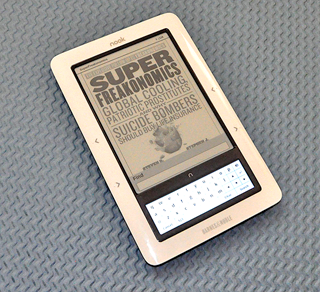 Two months ago, Barnes & Noble shipped its Nook, the most eagerly-anticipated e-book reader since Amazon’s Kindle. I thought it packed a number of nice touches and interesting features but that its software was decidedly rough around the edges, and advised that prospective buyers wait for promised updates before plunking down any money–which they’d have to do anyhow, since B&N was sold out and said it wouldn’t stock Nooks in its stores until it had fulfilled all the initial orders.
Two months ago, Barnes & Noble shipped its Nook, the most eagerly-anticipated e-book reader since Amazon’s Kindle. I thought it packed a number of nice touches and interesting features but that its software was decidedly rough around the edges, and advised that prospective buyers wait for promised updates before plunking down any money–which they’d have to do anyhow, since B&N was sold out and said it wouldn’t stock Nooks in its stores until it had fulfilled all the initial orders.
This week marks the Nook’s second chance at a first impression. Barnes & Noble started rolling out a software update, 1.2, over the weekend, and says that Nooks will finally arrive at retail in the middle of this week–just in time, it says cheerfully, for Valentine’s Day. I tried the revised software, and it’s a start–the Nook’s interface feels more spritely and less buggy, and some usability issues with the original version have been cleaned up. Icons now make it clearer which books can be lent out virtually for two weeks via B&N’s LendMe feature. (The company says “most” books offer the feature, but only about half of the ones I’ve bought do–notable exceptions include Superfreakonomics and The Four-Hour Work Week.) The Nook now offers some exclusive content and discounts (such as a 10 percent off sale on CDs) when it notices you’re on the Wi-Fi network of one of its stories.
4 comments
No Nook By Christmas? Barnes & Noble’s Giving You $100
 For those individuals who ordered their Nooks early, planning to give them as Christmas presents, hearing they will not be there in time is certainly not welcome news. However, Barnes & Noble is doing all it can to make sure they’re compensated for the company’s snafu.
For those individuals who ordered their Nooks early, planning to give them as Christmas presents, hearing they will not be there in time is certainly not welcome news. However, Barnes & Noble is doing all it can to make sure they’re compensated for the company’s snafu.
“A very small percentage of customers” that ordered for pre-Christmas shipping that will not be fulfilled will receive a $100 gift certificate to the retailer, the company said Monday. Those affected were alerted on Friday. If you ask me, its a pretty sweet consolation prize considering these folks essentially just got the device for $159.
Here’s an idea: give the gift card to the recipient and you just bought them a few books to go along with their shiny new Nook when it arrives!
Like the Kindle, the Nook is seeing the same problems with fulfilling demand early on. There is about a two month wait — at least — for those who ordered their devices after November 20. If Amazon’s history with Kindle sales is any indication, it could be well into the new year before supply and demand equalizes.
In any case, this demand should be heartening to the e-book/e-reader industry as a whole. It now appears that there is a large enough market for these devices, something that some analysts questioned early on during the days of the Kindle.
Maybe too it might just be a fad — that’s entirely possible and God knows tech has had so many gadget ideas that come in a blaze of glory and exit stage right with its tail between its legs.
As for me? I personally still like the idea of paper too much, but maybe I’m old fashioned…
One comment
Your First Look at Nook: The Technologizer Review
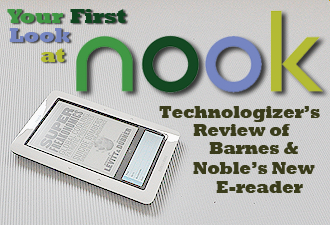
That response is the Barnes & Noble Nook, and its arrival this week signals the start of a digital transition for the bookselling wars. The Nook has much in common with the Kindle, from its playful name to the paper-esque E-Ink display to built-in 3G wireless that lets you start reading a book seconds after you’ve decided to buy it. Even the prices–$259 for the device itself, and $9.99 for most bestsellers–are identical.
(Like Amazon and Apple, B&N likes to refer to its creation without a modifying article, and also dispenses with capitals–“nook lets you loan eBooks” rather than “The Nook lets you loan eBooks.” I’ve honored the lack of a “the” in the title of this article, but will blithely ignore it from here on out.)
For all their similarities, the Nook packs more pizzazz than Amazon’s e-reader, in the form of the color touchscreen it uses for much of its navigation. It aims to be more open, letting you read tomes you buy on PCs, Macs, iPhones, and BlackBerries–and even on e-readers from companies other than Barnes & Noble. And it brings back a virtue of dead-tree books that people have taken for granted for centuries: the ability to loan them to pals.
For this review, I got to spend some quality time with a Nook, running the software version which will be installed on the first Nooks to reach customers. As I was finishing up my review, B&N was racing to ready itself for the Nook’s debut this week–a few features weren’t yet up and running, or had rough edges that may be eliminated by the time the first consumers turn on their Nooks for the first time.
117 comments
More Power, PDF for the Kindle
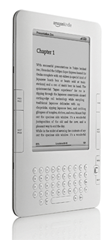 There’s almost no such thing as “enough” in the world of tech. But Amazon’s Kindle e-reader, which can run for two weeks on a charge, surely has enough battery life. But the two-week figure only applies if you shut off the gizmo’s 3G data connection. Leave it on, and you reduce the list to four days.
There’s almost no such thing as “enough” in the world of tech. But Amazon’s Kindle e-reader, which can run for two weeks on a charge, surely has enough battery life. But the two-week figure only applies if you shut off the gizmo’s 3G data connection. Leave it on, and you reduce the list to four days.
Until now: Amazon says that it’s managed to improve wireless-on life to seven days on a charge, which surely counts as enough. It’s also added native support for documents in PDF format. (Until now, you’ve had to convert PDFs to the Kindle’s native format to read them.)
The best news: Existing owners of the current Kindle model will get both of these enhancements via an over-the-air software update. Owners of “some” earlier Kindles will get the PDF support, but not the extended battery life.
It may not be entirely coincidental that Amazon is making this announcement shortly before the arrival of Barnes & Noble’s Nook. That imposing Kindle competitor has more features overall than Amazon’s e-reader has had, including PDF support. I don’t see a figure for wireless-on battery life in B&N’s specs list, but the Nook goes for ten days if you turn the wireless off. Which is still a heck of a lot longer than most electronic devices, but the device’s color touchscreen presumably sucks enough power to reduce the life compared to that of the Kindle.
Both the Kindle and the Nook still have some features that the other one doesn’t. The Kindle, for instance, can read books out loud and has a crude Web browser; the Nook has Wi-Fi as well as 3G and lets you lend books to Nook-owning pals. I’m not going to come to any conclusions about whether there’s a clear winner until the Nook shows up, but it’s going to be fun to watch the two book megamerchants duke it out.
4 comments
E-Reader vs. E-Reader: Spring Design Sues Barnes & Noble
Back on October 19th, a company called Spring Design introduced an e-reader called Alex. It had two significant features in common with Barnes & Noble’s Nook, which was introduced a day later: Both sport a large monochrome e-ink screen and a smaller touch-sensitive color display below, and both run Google’s Android OS.
Spring Design is now saying that the similarity is too close for comfort, and that it’s suing Barnes & Noble:
Spring Design first developed and began filing patents on its Alex e-book, an innovative dual screen, Android-based e-book back in 2006. Since the beginning of 2009 Spring and Barnes & Noble worked within a non-disclosure agreement, including many meetings, emails and conference calls with executives ranging up to the president of Barnes and Noble.com, discussing confidential information regarding the features, functionality and capabilities of Alex. Throughout, Barnes & Noble’s marketing and technical executives extolled Alex’s “innovative” features, never mentioning their use of those features until the public disclosure of the Nook.
I’m not a lawyer, and have no insight into the backstory here–and while I’ve played a bit with an Alex, I’ve yet to see a Nook in the flesh. So I’m not taking sides. But the two e-readers do look similar (that’s the Alex on the left):
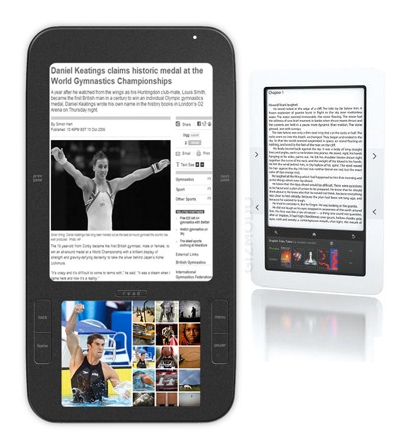
One way or another, I hope this is resolved quickly: The Nook is due to ship late this month, and is, for the moment, the Amazon Kindle’s most promising competitor. Spring’s press release doesn’t say whether its goal is to prevent B&N from shipping the Nook at all
2 comments
Plastic Logic E-Reader @ Barnes and Noble
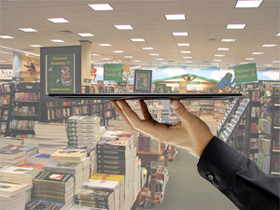 Back before Barnes & Noble announced its Nook e-reader, some folks wondered whether the rumored B&N e-book device would simply be the one from Plastic Logic. It wasn’t. But today, Barnes & Noble and Plastic Logic announced that B&N would be selling Plastic Logic’s QUE in stores and online.
Back before Barnes & Noble announced its Nook e-reader, some folks wondered whether the rumored B&N e-book device would simply be the one from Plastic Logic. It wasn’t. But today, Barnes & Noble and Plastic Logic announced that B&N would be selling Plastic Logic’s QUE in stores and online.
I was startled by the news at first blush, but upon reflection, it makes sense. The QUE has a larger display than the Nook, giving B&N a counterpart to Amazon’s jumbo-screened Kindle DX to sell. It calls itself a PROreader and is aimed at business types. And while we don’t know all of the QUE’s specs, it has enough in common with the Nook–AT&T 3G wireless, Wi-Fi, a touchscreen, and access to all the content in B&N’s online bookstore–that they’ll make sense as a set.
For all of the Kindle’s apparent success–I say “apparent” because Amazon doesn’t release specific sales figures–most of the book lovers in America still haven’t seen an e-reader in person, let alone bought one. (Borders sells Sony’s Reader, but it does so at a lonely little kiosk that I rarely see anyone paying attention to.) We still don’t know how long a future e-readers have, but if Barnes & Noble pours its heart into selling them, it’ll be as significant a moment in the gadget’s history as Amazon’s introduction of the Kindle a couple of years ago.
3 comments
The E-Reader Explosion: A Cheat Sheet
 By almost any imaginable definition, last week was the newsiest ever in the still-new world of e-book readers. We witnessed the unveiling of Barnes & Noble’s ambitious Nook. We got more details about Plastic Logic’s long-awaited device. We learned of an underdog known as the Spring Design Alex. We were informed that Amazon was killing the original Kindle 2 and lowering the price of the model with international roaming, and saw a demo of an upcoming Amazon Kindle reader application for Windows (a Mac version is also in the works). In short, the era in which it was logical to use “Kindle” as shorthand for “book-reading gizmo” is over.
By almost any imaginable definition, last week was the newsiest ever in the still-new world of e-book readers. We witnessed the unveiling of Barnes & Noble’s ambitious Nook. We got more details about Plastic Logic’s long-awaited device. We learned of an underdog known as the Spring Design Alex. We were informed that Amazon was killing the original Kindle 2 and lowering the price of the model with international roaming, and saw a demo of an upcoming Amazon Kindle reader application for Windows (a Mac version is also in the works). In short, the era in which it was logical to use “Kindle” as shorthand for “book-reading gizmo” is over.
It seems like a good time, then, to put some basic facts and figures about a bunch of major and/or new e-reader competitors in one place. After the jump, a quick Technologizer Cheat Sheet.
